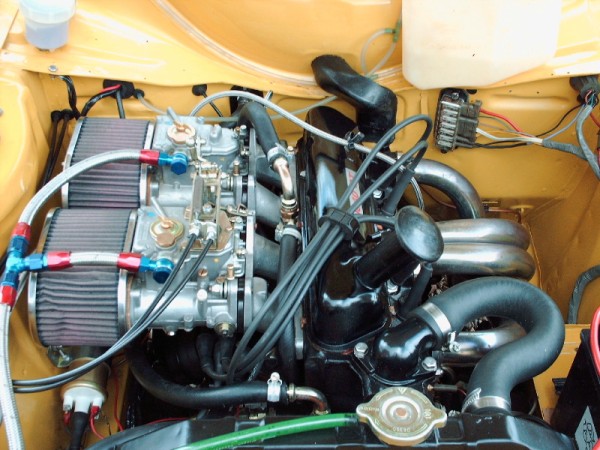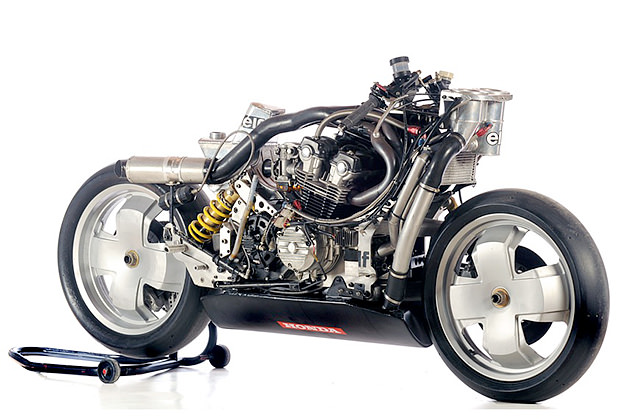Transverse mid engined cars
Discussion
A stunning bit of engineering for 1965...

taken from here:
http://www.ultimatecarpage.com/cg/1308/Honda-RA272...

taken from here:
http://www.ultimatecarpage.com/cg/1308/Honda-RA272...
xRIEx said:
RobM77 said:
MGJohn said:
doogz said:
RobM77 said:
wasn't the person saying that, but I read it and thought no more of it as it sounded right to my untrained mind. What would make the CofG higher on a boxer (or a flat engine?) higher than a V? I'm trying to think what would offset the higher cylinder heads of the V. Genuine question - I have no strong feelings either way, but it just tickled my curiousity.
The boxer engine itself has a lower CoG than a V engine generally would.But they tend to be mounted higher, to allow for the manifold underneath.
Scuffers said:
RobM77 said:
Why can't they be combined then? Many cars have inlet and exhaust attached to the same side of the engine.
we used to have engines like that, X-flow etc, but they were s t by comparison and near impossible to make with multi-valve engine designs.
t by comparison and near impossible to make with multi-valve engine designs.Scuffers said:
RobM77 said:
Why can't they be combined then? Many cars have inlet and exhaust attached to the same side of the engine.
we used to have engines like that, X-flow etc, but they were s t by comparison and near impossible to make with multi-valve engine designs.
t by comparison and near impossible to make with multi-valve engine designs.xRIEx said:
Scuffers said:
RobM77 said:
Why can't they be combined then? Many cars have inlet and exhaust attached to the same side of the engine.
we used to have engines like that, X-flow etc, but they were s t by comparison and near impossible to make with multi-valve engine designs.
t by comparison and near impossible to make with multi-valve engine designs.I mean to say pre X-flow.... (back to the dog house!)
doogz said:
RobM77 said:
Why can't the manifold be on top? Sorry if I'm hijacking the thread to ask basic engine questions!
The manifold is on the top. The inlet one.The exhaust manifold is underneath.
Makes sense to have them that way around as the intercooler is top mounted, flat, just infront of the windscreen, just under where the bonnet vent is, funnily enough.
Didn't you ever work on your Metro? Or at least, lift the bonnet?
Or was yours an A-series?
doogz said:
RobM77 said:
A Series, so combined inlet and exhaust interspliced. As I said above, I've not worked on modern cars at all, and I've only ever owned in-line engines, never V or flat.
Fair enough, the 5 port head.Still, pretty much every inline engine built since then has had the inlet on one side, the exhaust on the other. Your single seater I'm quite sure, will have been like this, your BMW, your Lotus, etc.
 Indeed they were/are, yes; however the Metro remains the only engine I've ever worked on as it's the only racing car I've ever run on my own; it had a full race engine so required a rebuild once every season or two, which I used to do myself. My road cars are needed almost every day, so I've only done very minor jobs on them, and road cars don't really interest me anyway. However, all of this is beside the point a bit!!! Regarding the manifolds, obviously there's no problem for having them either side in most inline engine installations, as the room is usually there on both sides. My question arose purely because "the manifold is there" is not a very complete answer, and nor does it mention inlet or exhaust, in fact its mention in the singular ('manifold'), rather than the plural ('manifolds') made me think not of a mdoern engine, but of my A series. I was just interested to know more (as usual!)
Indeed they were/are, yes; however the Metro remains the only engine I've ever worked on as it's the only racing car I've ever run on my own; it had a full race engine so required a rebuild once every season or two, which I used to do myself. My road cars are needed almost every day, so I've only done very minor jobs on them, and road cars don't really interest me anyway. However, all of this is beside the point a bit!!! Regarding the manifolds, obviously there's no problem for having them either side in most inline engine installations, as the room is usually there on both sides. My question arose purely because "the manifold is there" is not a very complete answer, and nor does it mention inlet or exhaust, in fact its mention in the singular ('manifold'), rather than the plural ('manifolds') made me think not of a mdoern engine, but of my A series. I was just interested to know more (as usual!) 
There was a Honda race bike (ELF?) where they had the fuel tank at the bottom of the chassis, and the exhaust (expansion chambers) running over the engine where the fuel tank usually is.
Their theory was that the exhaust system was light but bulky, so taking it over the top lowered the COG.
Not a very successful bike, by the way, by Honda standards.
Their theory was that the exhaust system was light but bulky, so taking it over the top lowered the COG.
Not a very successful bike, by the way, by Honda standards.
Scuffers said:
to a point, yes, but just because the engine/box are a fixed item to each other does not mean you can't rotate the whole package.
what I am getting at is that in a FWD scenario, you want the drive line as far forward as possible whilst keeping the engine as far back as you can get, some of this is achieved by slanting the engine over the driveline (this also keeps the bonnet height down at the front of the car).
A more rearwards weight distribution is also one of the expected outcomes of turning the engines around (in FWD cars) so that the inlet goes into the engine from the front of the car and the exhaust goes out the back. If you look at the engine of a CL9 Honda Accord Euro what looks like exhaust headers coming out of the front of the engine is actually the intake manifold. I think the cylinder head lies directly overhead of the driveshafts (give or take a few degrees).what I am getting at is that in a FWD scenario, you want the drive line as far forward as possible whilst keeping the engine as far back as you can get, some of this is achieved by slanting the engine over the driveline (this also keeps the bonnet height down at the front of the car).
That said, in the back of my mind I thinking that there's some car which takes both the rotation and backwards facing aspects to the extreme, with the front wheels quite a way forward and the engine quite a way back. Google throws up the Renault 16 but I'm thinking something in the past five years (maybe another Renault?)
AW111 said:
There was a Honda race bike (ELF?) where they had the fuel tank at the bottom of the chassis, and the exhaust (expansion chambers) running over the engine where the fuel tank usually is.
Their theory was that the exhaust system was light but bulky, so taking it over the top lowered the COG.
Not a very successful bike, by the way, by Honda standards.
You probably mean the first iteration of the Honda NSR500 (mid-80's):Their theory was that the exhaust system was light but bulky, so taking it over the top lowered the COG.
Not a very successful bike, by the way, by Honda standards.

It didn't do that badly, they won the world championship with it in 1985.
Gassing Station | General Gassing | Top of Page | What's New | My Stuff





